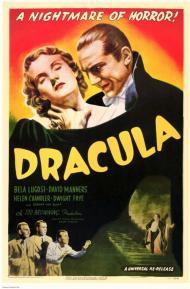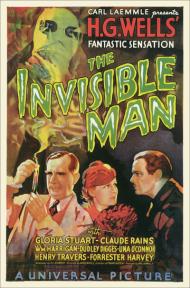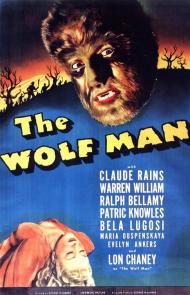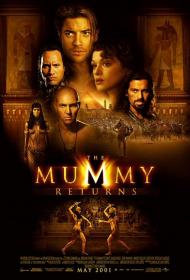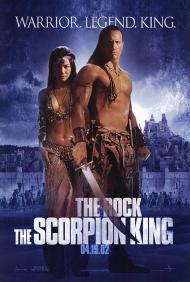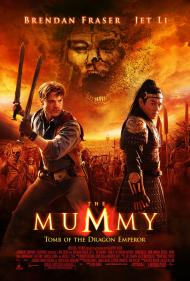Movie Review
The Mummy
It Comes to Life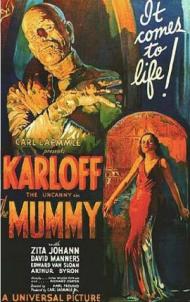
US Release Date: 12-22-1932
Directed by: Karl Freund
Starring▸▾
- Boris Karloff, as
- Imhotep
- Zita Johann, as
- Helen Grosvenor/Ankh-es-en-amon
- David Manners, as
- Frank Whemple
- Arthur Byron, as
- Sir Joseph Whemple
- Edward Van Sloan, as
- Doctor Muller
- Bramwell Fletcher, as
- Ralph Norton
- Noble Johnson, as
- The Nubian
- Kathryn Byron, as
- Frau Muller
- Leonard Mudie, as
- Professor Pearson
- James Crane as
- The Pharaoh
![2.75 star[s] out of 4](http://www.threemoviebuffs.com/static/images/global/featured_gold_stars.png)
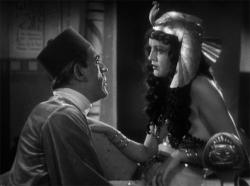
Boris Karloff and Zita Johann in The Mummy.
Universal Pictures was well-known in the 1930s as the home of horror, producing such films as Dracula, Frankenstein and The Mummy and making unlikely stars of Bela Legosi and Boris Karloff in the process. Although they can seem quaint when watched today and not very frightening, there are still things to enjoy about them.
One of the best things about this movie and perhaps the most famous, is the makeup. Karloff in full mummy regalia is impressive. The moment when the mummy actually starts to move is the closest thing this movie comes to being frightening. But surprisingly to me, the mummy is only in this makeup for one very, very brief scene. For the rest of the film, he looks basically human, with just a touch of makeup to give the odd looking Karloff, an even odder look, but the bandages are long gone.
The other surprise to me was how much the 1999 film The Mummy actually reused plot elements from this one. I'm not sure why, but I'd always assumed that the two had nothing in common except the title. In fact, the backstory of the mummy, Imhotep and his lost love, Ankh-es-en-amon, is nearly identical in both versions. It is only in the people who discover the mummy that the stories differ.
In this version, the story opens in 1921 during an excavation in Egypt. The mummy of former high priest Imhotep is discovered along with a scroll. When the scroll is translated and read out loud, the mummy comes back to life. It steals the scroll and runs away. Cut to 10 years later and Imhotep now looks fairly human and he wants a new group of archeologists to dig up his former lover who is buried near by. We learn that Imhotep was mummified alive for trying to read from the forbidden scroll that would have allowed him to raise his love Ankh-es-en-amon from the dead. Things are complicated further when he discovers that the girlfriend of one of the archeologists is in fact the reincarnation of Ankh-es-en-amon.
What's interesting about this movie is that although the mummy is supposedly the monster, his motive is simply to get back the woman he loved so much that he dared to face eternal hell. He's not so much evil as just determined and willing to do whatever it takes (including murder) to accomplish this goal. He is definitely the most interesting character and I was actually rooting for him rather than the boring archeologist "heroes".
It still baffles me that the movie's most iconic image is only in it for about 5 seconds, but at an hour and ten minutes, the story flies by. Sure, it owes more than a little of its plot to Dracula, released just a year earlier, but overall it's a nice enough, if very dated, little film.
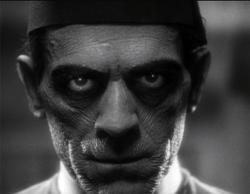
Boris Karloff as The Mummy.
Boris Karloff is great as Imhotep. He is a fairly powerful being and (as Scott wrote) hell bent on reuniting with his long lost love. Although there is only the one brief scene of him in his full mummy regalia there are several close-ups of his horrific visage and hypnotic eyes that are the movies’ most famous shots (see photo at left).
The early scene where he is brought back to life holds up well. The archeologist that reads the scroll that resurrects Imhotep loses his mind when he sees the mummy come to life. He begins laughing maniacally and, it is later reported, literally laughs himself to death. It is his son that rediscovers the mummy 10 years later.
Most of the deaths occur off-screen. This movie is suspenseful without being at all gory. In one interesting scene Imhotep rigs up a sort of pensieve to show the hypnotized Helen (his reincarnated lover) what happened to him in his past life in Egypt 37 hundred years ago.
The King Tut exhibit that came to the United States in the 1920s caused a furor for all things related to ancient Egypt. The Mummy clearly took advantage of this surge in popularity, creating a famous horror character and a box office hit. It is not a masterpiece like Frankenstein or as iconic as Dracula or The Wolf Man. But this original version of The Mummy is worth checking out.
![2.5 star[s] out of 4](http://www.threemoviebuffs.com/static/images/global/featured_gold_stars.png)
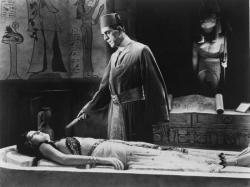
Zita Johann and Boris Karloff in The Mummy
Patrick wrote that the deaths are not at all gory, but the spear through the slave's mid section during a flash back is pretty graphic. Made before the Hayes Code was enforced, they also got to show Zita Johann wearing a very revealing little top when dressed as Ankh-se-en-amon.
Scott wrote that The Mummy is essentially a love story with murder. Imhotep and Ankh-es-en-Amon say to each other, "My love has lasted longer than the temples of our gods. No man ever suffered as I did for you." The problem is that Karloff is so damn ugly and creepy that we only ever see him as a monster and never as a leading man motivated by love. He never garners the least bit of our sympathy.
Made so long ago, I liked that some of the dialogue has different meanings today. When Johann says, "Don't you think I've had enough excitement for one evening, without the additional thrill of a strange man making love to me?" She did not mean she was turning down sex with a man she had just met. When an archeologist says about Imhotep, "Maybe he got too gay with the vestal virgins in the temple." He was not speaking of any homosexual act.
Another historical note is that The Mummy opens with some footage of actual ancient Egyptian ruins. It could be interesting to use this footage shot so many decades ago and compare it to how it looks today. We could see how much has been unearthed and how much has deteriorated since. We can also view this movie as historically important to Hollywood. It spawned many lesser known sequels as well as several remakes. My brothers mentioned the brief appearance of the Mummy in wrapping, but that image was so strong that it has lasted all this time.
Photos © Copyright Universal Pictures (1932)

